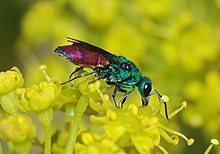
Wasps of the genus Sphex are cosmopolitan predators that sting and paralyze prey insects. Sphex is one of many genera in the old digger wasp family Sphecidae, though most apart from the Sphecinae have now been moved to the family Crabronidae. There are over 130 known Sphex species.

Pepsis is a genus of spider wasps belonging to the family Pompilidae.

Hedychrum rutilans is a species of cuckoo wasps. The species occurs primarily in Austria, Italy, Bulgaria, Greece, France, Poland, Portugal, Spain, Switzerland and in North Africa. The head and thorax are metallic green with red spots, while the abdomen is red. The color is more green and partially golden in the male and more extensively golden-red in the female. The body is somewhat hairy.
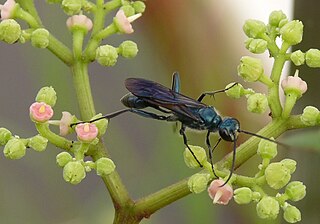
Chalybion is a genus of blue mud dauber wasps in the family Sphecidae. Chalybion species nest in a wide range of natural and artificial cavities such as holes in wood, walls, plant stems, etc., where they typically provision their brood cells with paralyzed spiders. They also reuse old nests of other wasps like Trypoxylon and Sceliphron.
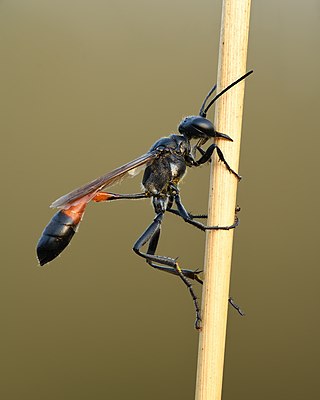
Ammophila is the type genus of the subfamily Ammophilinae of the hunting wasp family Sphecidae. Ammophila is a large and cosmopolitan genus, with over 200 species, mostly occurring in the warmer regions of all continents apart from Antarctica.

Chrysis is a very large genus of cuckoo wasps. It is the largest genus in the family, including over 1,000 species in over 20 subgenera, as speciose as all remaining Chrysididae combined. The generic name is derived from Greek chrysis, "gold vessel, gold-embroidered dress", and pays tribute to the brilliant metallic appearance of wasps in the genus.

Chrysidini is a very large tribe of cuckoo wasps in the subfamily Chrysidinae; this tribe contains more than half of all chrysidid species.
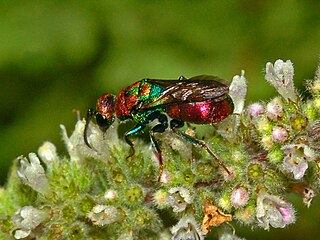
Hedychrum is a large genus of cuckoo wasps. With roughly 150 species, it is the second largest genus in the family; most species are from the Palaearctic, but they can be found in the Oriental, Afrotropical, Nearctic, and Neotropical regions. Their hosts are typically from the subfamily Philanthinae.
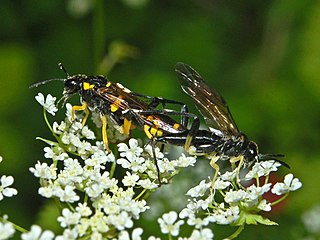
Macrophya is a genus of sawfly.
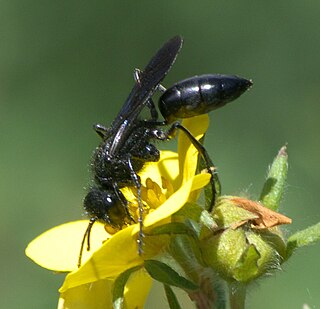
Podalonia is a genus of parasitoidal wasps in the family Sphecidae.

Prionyx is a genus of wasps in the family Sphecidae. They are known to hunt and feed on grasshoppers.

Holopyga is a genus of cuckoo wasps.
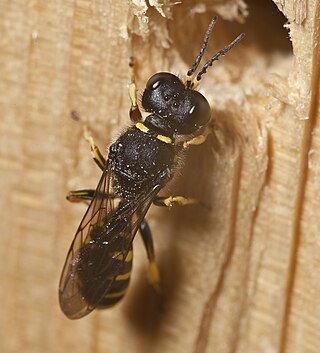
Ectemnius is a genus of wasps in the family Crabronidae. 188 species are known. The genus is found around the world but Australia has only two species.

Oxybelus is a genus of wasps in the family Crabronidae. The species are found worldwide except in the Australasian realm. They are especially represented in the Palearctic. Oxybelus is the largest genus in Crabronidae, with 264 species known. Oxybelus wasps sometimes gravitate towards people, flying around travellers and landing on them, even when they are shooed away. It is not known why they do it, however it might possibly be them trying to drink sweat for its minerals.
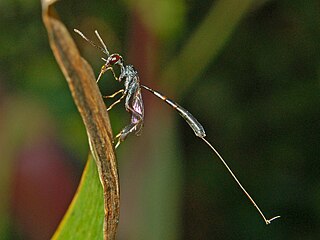
Gasteruption is a genus of wasps belonging to the family Gasteruptiidae subfamily Gasteruptiinae.

Dryudella is a genus of wasps in the family Crabronidae. There are more than 50 described species in Dryudella.
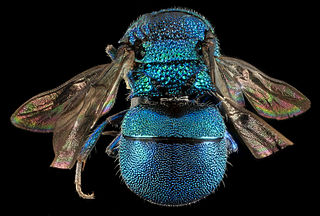
Elampini is a tribe of cuckoo wasps in the family Chrysididae.

Chrysura simplex is a species of cuckoo wasps, insects in the family Chrysididae.
Elampus is a genus of insects belonging to the family Chrysididae.
